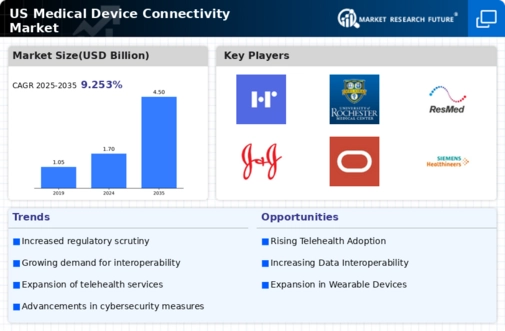The US Medical Device Connectivity Market is a fast-changing field that focuses on connecting medical devices so that data can be shared, communication can happen, and different healthcare systems and equipment can work together. As the need for better healthcare solutions grows, more and more manufacturers are interested in this industry.
They want to use connection to improve patient care, make operations more efficient, and get better results in healthcare. In this sector, companies compete by coming up with new technologies, forming strategic partnerships, and focusing on following the rules to make sure that connected medical devices are used safely and effectively. The interaction between existing businesses and new entrepreneurs makes the market more dynamic, creating an environment where improvements in device connectivity can quickly lead to real clinical benefits.
Medtronic is a major player in the US Medical Device Connectivity Market, using its many years of experience in the medical technology field to come up with new ways to connect devices. One of the company's main goals is to make integrated solutions that make it easier for devices to work together and share data.
Medtronic's strengths are its commitment to patient-centered solutions and the large amount of clinical data that backs up its products. Its strong portfolio includes insulin pumps, cardiac devices, and monitoring systems. The organization has a significant presence in the industry since it has built solid relationships with healthcare providers and has a reputation for being reliable and of high quality. Medtronic's ability to add advanced digital features to its devices is another reason why it is doing so well in the US market.
These tools let doctors monitor patients' health in real time and make decisions based on data in clinical settings.
Another important player in the US Medical Device Connectivity Market is Hillrom. They focus on making connected solutions that make it easier to keep an eye on patients and improve hospital workflows. The company makes a variety of products, including as advanced patient monitoring systems, hospital beds, and rehabilitation therapy solutions. All of these products are meant to work together to improve patient care.
Hillrom takes use of its significant market position by forming strategic relationships and working with other companies in the healthcare ecosystem. This makes it easier for hospitals to use its products. The company's drive on innovation is clear from its investments in digital health technology and networking, which help healthcare providers collect and analyse patient data more effectively. Through mergers and acquisitions, Hillrom has solidified its place in the market. These deals have allowed the company to get new technologies and synergies that improve its product line.
These kinds of smart measures help Hillrom keep growing and stay ahead of the competition in the ever-changing US Medical Device Connectivity Market.












